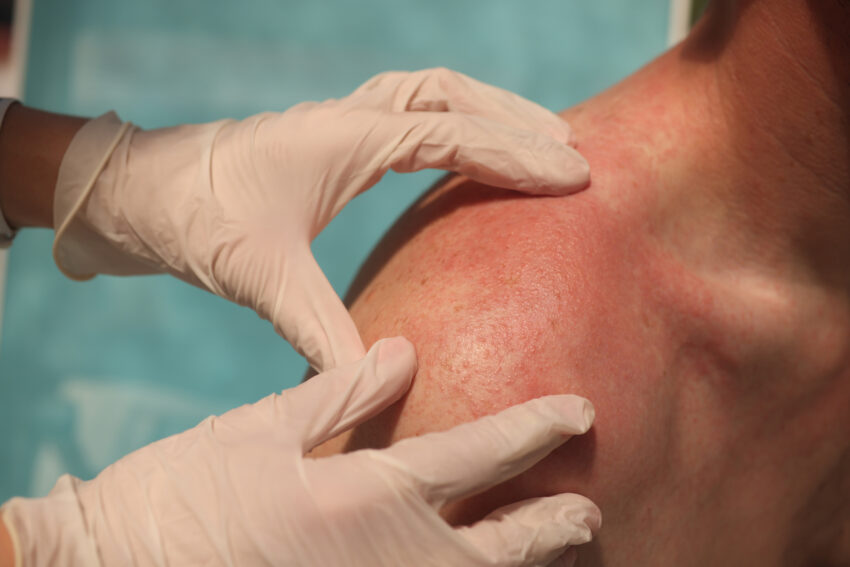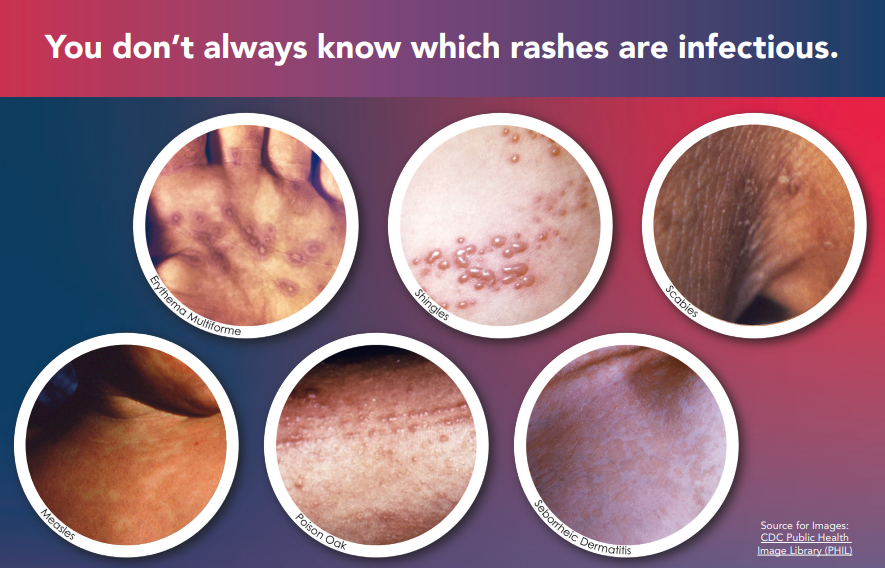
Share On Social!
CDC’s Project Firstline knows that healthcare workers are short on time, but this shouldn’t limit access to practical and valuable infection control training.
That’s why CDC’s Project Firstline developed Infection Control Micro-Learns – a series of guided infection control discussions that can be easily incorporated into team meetings or huddles facilitated by an experienced team member with infection control expertise.
These short and easy-to-understand learning opportunities can help healthcare workers recognize and minimize infection control risks to protect themselves, coworkers, and patients from infectious diseases.
Let’s explore the Infection Control Micro-Learn on rashes!
What to Do When You See a Patient with a Rash
A rash is abnormal skin that is usually red, irritated, or broken and may have bumps, flat spots, or blisters.

A rash can be caused by many things, including germs that spread by touch, viral infections, an injury, or an allergic reaction. You may not be able to tell what has caused the rash just by looking at it.
Regardless of the cause, any rash is a vulnerable area where germs can enter the body and spread to other people or surfaces.
Therefore, you shouldn’t touch the patient’s rash if you don’t have to. If you must touch a rash, use gloves. Don’t forget to clean your hands after you remove your gloves!
If it’s possible to cover the rash, it’s often best to do so, but there are some exceptions. This decision is made by the clinical team.
Germs can spread from a rash to anything that touches it, so make sure to clean and disinfect surfaces and properly handle linens that have touched the rash.
If the patient with the rash also has a cough and congestion, consider the possibility that it is caused by a virus that spreads through the air, and separate the patient from others. Consult with the clinical and infection prevention teams, and consider whether additional infection control actions are necessary, such as putting the patient in a separate room with the door closed.
Explore the Infection Control Micro-Learn on rashes, including the discussion guide and visual job aid!
What Can You Do to Promote Infection Control in Your Healthcare Setting?
Help keep yourself, your colleagues, and your patients safe from infectious disease threats by building on your infection control knowledge!
To show your dedication, sign this pledge to complete an infection control training or activity through CDC’s Project Firstline!
You can also share infection control training opportunities with healthcare colleagues via LinkedIn with our Project Firstline social media toolkit.
You can access more information about infection prevention and control in healthcare by visiting resources from CDC Project Firstline.
Salud America! at UT Health San Antonio is working with the National Hispanic Medical Association to bring Project Firstline infection control educational content to healthcare workers, so they are equipped with the knowledge they need to protect themselves, their facilities, and their patients (Latinos and all communities) from infectious disease threats in healthcare settings.
Check out some of the articles from this partnership:
- What is Project Firstline?
- What is the Goal of Infection Prevention and Control in Healthcare Settings?
- What’s a Virus?
- What is Ventilation and Why Does It Matter?
- Contact Time: What is It and How Does it Impact Infection Control?
- The Surprising Difference Between Cleaning and Disinfection
- What’s a Respiratory Droplet and Why Does It Matter?
- We Need to Talk about Hand Hygiene Again
- Why are Gowns, Gloves, and Eye Protection Recommended for COVID-19?
Check out some of the Latino healthcare workers who are heroes for infection control:
- Anna Valdez: Tackling Infection Control with Education from Classroom to Clinic
- Wanda Montalvo: Preventing Infections in Community Health Centers, Latino Communities
- Ricardo Correa: Endocrinologist and Infection Control Leader for the Latino Community
Learn More about Project Firstline!
Editor’s Note: This article is part of a collaboration between Salud America!, the National Hispanic Medical Association, and the CDC’s Project Firstline. To find resources training materials, and other tools to bolster knowledge and practice of infection control, visit Project Firstline and view Salud America!’s infection control content.
Explore More:
Healthy Families & SchoolsBy The Numbers
142
Percent
Expected rise in Latino cancer cases in coming years



